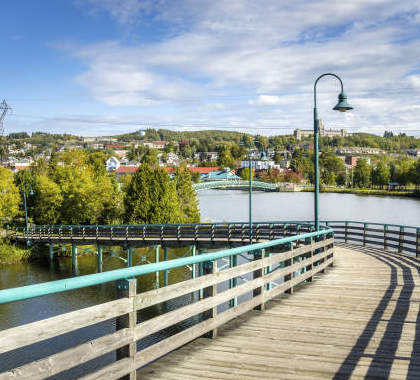
| # | City | Population | Area (km 2) | Livability Score |
| 1 | Saint John | 70,776 | 316 | 86 |
| 2 | Fredericton | 63,818 | 133 | 84 |
| 3 | Dieppe | 27,260 | 54 | 65 |
| 4 | Riverview | 19,441 | 35 | 73 |
| 5 | Quispamsis | 19,102 | 57 | 65 |
| 6 | Miramichi | 17,761 | 179 | 56 |
| 7 | Edmundston | 16,970 | 107 | 73 |
| 8 | Tracadie | 16,034 | 517 | 50 |
| 9 | Moncton | 11,235 | 142 | 76 |
| 10 | Oromocto | 9,784 | 22 | 74 |
| 11 | Lincoln | 7,885 | 160 | 58 |
| 12 | Beaubassin East / Beaubassin-est | 6,880 | 291 | 56 |
| 13 | Douglas | 6,862 | 1,447 | 57 |
| 14 | Campbellton | 6,678 | 19 | 56 |
| 15 | Beresford | 6,264 | 19 | 60 |
| Statistic | Value |
| Population | 779,582 |
| Population Density | 11 ppl. / sq. mi. |
| Median Age | 46 |
| Male To Female Ratio | 1.02 : 0 |
| Married (15yrs & older) | 66.39% |
| Families w/ Kids under 18 | 36.79% |
| Speak English | 57.48% |
| Statistic | Value |
| Median Household Income | $70,223 |
| Unemployment Rate | 5% |
| No Certificate | 21% |
| Completed High School | 79.48% |
| Bachelors Degree | 13% |
| Masters Degree | 5% |
| Avg. School Score | n/a% |
| # | City | Population | Area (km 2) | Livability Score |
| 1 | Saint John | 70,776 | 316 | 86 |
| 2 | Fredericton | 63,818 | 133 | 84 |
| 3 | Moncton | 11,235 | 142 | 76 |
| 4 | Oromocto | 9,784 | 22 | 74 |
| 5 | Sussex | 2,551 | 9 | 74 |
| 6 | Edmundston | 16,970 | 107 | 73 |
| 7 | Riverview | 19,441 | 35 | 73 |
| 8 | New Maryland | 3,050 | 21 | 72 |
| 9 | Saint Andrews | 562 | 8 | 71 |
| 10 | McAdam | 1,189 | 14 | 69 |
| 11 | Nackawic | 964 | 8 | 69 |
| 12 | St. George | 1,555 | 16 | 67 |
| 13 | St. Basile 10 | 221 | 3 | 66 |
| 14 | Petitcodiac | 1,451 | 17 | 66 |
| 15 | Woodstock | 2,241 | 15 | 65 |
It is obvious why over 765,000 people call New Brunswick home. While some may want to live in more urban areas, others may want to settle in more remote ones, with nature as their backyard. New Brunswick is one of the smaller Canadian provinces population-wise, but it offers diversity in language and culture that stands out among the others. If you are considering moving to New Brunswick, it may be your lucky day, because housing here is some of the cheapest in Canada.
New Brunswick is located on Canada’s east coast, and is one of the four Atlantic provinces (Newfoundland and Labrador, Prince Edward Island and Nova Scotia are the others). It is a bilingual province, with about one-third of the population speaking both English and French. Only about half of New Brunswick’s residents live in cities, such as Greater Moncton, Greater Saint John and Fredericton. Along with being close to the other Atlantic provinces, New Brunswick is relatively close to Quebec, as well as the U.S. states of Maine, New Hampshire and Massachusetts.
New Brunswick borders Quebec, the Bay of Fundy, the Atlantic Ocean and Maine. Much of its terrain is forest far from water, making weather harsh. There are, however, urban areas situated by water. It has a humid continental climate, with mild winters in parts, and a subarctic climate in others. Frequent winter thaws and less snow have become common over time in New Brunswick overall. Even so, all four seasons are experienced, and summers are mild, but the severity of the winter depends on where one is.
Those looking for a modern, bilingual experience should look no further than New Brunswick. Thanks to a rich cultural framework, numerous attractions and distinct seasons, there is plenty to do. Irving Nature Park and Tidal Bore are popular for an escape into nature, while Magnetic Hill Zoo, Fredericton Boyce Farmers Market and Kingsbrae Garden are ideal for culture buffs. Moncton, especially, is a cultural center of urban parks, theatres and museums.